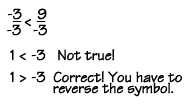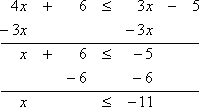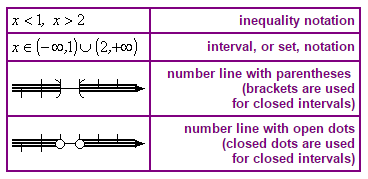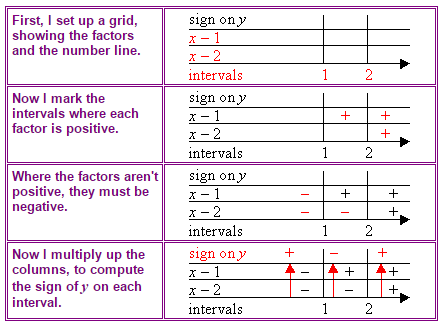Inequality tells us about the relative size of two values. Mathematics is not always about "equals". Sometimes we only know that something is bigger or smaller. Just like with equations, the solution to an inequality is a value that makes the inequality true. You can solve inequalities in the same way you can solve equations, by following these rules:
- You may add any positive or negative number to both sides of an inequality.
- You may multiply or divide both sides of an inequality by any positive number.
NOTE: If you multiply or divide both sides of an inequality by a negative number, reverse the direction of the inequality sign.
Solving an inequality is very similar to solving an equation. You follow the same steps, except for one very important difference. When you multiply or divide each side of the inequality by a negative number, you have to reverse the inequality symbol! Let's try an example:
-4x > 24
Since this inequality involves multiplication, we must use the inverse, or division, to solve it. We'll divide both sides by –4 in order to leave x alone on the left side.
When we simplify, because we're dividing by a negative number, we have to remember to reverse the symbol. This gives "x is less than –6," not "x is greater than –6."
x < -6
Why do we reverse the symbol? Let's see what happens if we don't. Think about the simple inequality –3 < 9. This is obviously a true statement.
-3 < 9
To demonstrate what happens when we divide by a negative number, let's divide both sides by –3. If we leave the inequality symbol the same, our answer is obviously not correct, since 1 is not less than –3.
We must reverse the symbol in order to find the correct answer, which is "1 is greater than –3".
Example
The only difference between the linear equation "4x + 6 = 3x – 5" and this inequality is the "less than or equal to" sign in place of a plain "equals" sign. The solution method is exactly the same.
Note that the solution to a "less than or equal to" inequality is graphed with a square bracket (or else a closed dot) at the endpoint, indicating that the endpoint is included within the solution. Graphically, the solution is:
Another example is the following:
The only difference between the linear equation "2 – x = 0" and this linear inequality is the "greater than" sign in place of an "equals" sign. Note that "x" in the solution does not "have" to be on the left. However, it is often easier to picture what the solution means with the variable on the left. Don't be afraid to rearrange things to suit your taste. Graphically, the solution is:
The last example is the following:
This is the special case. When we divided by the negative two, we had to flip the inequality sign. Graphically, the solution is:
The rule for the example above often seems unreasonable to students the first time they see it. But think about inequalities with numbers in there, instead of variables. You know that the number four is larger than the number two: 4 > 2. Multiplying through this inequality by –1, we get –4 < –2, which the number line shows is true:
If we hadn't flipped the inequality, we would have ended up with "–4 > –2", which clearly isn't true, but false.
Quadratic Inequality
The previous inequalities are called "linear" inequalities because we are dealing with linear expressions like "x – 2" ("x > 2" is just "x – 2 > 0", before you finished solving it). When we have an inequality with "x2" as the highest-degree term, it is called a "quadratic inequality". The method of solution is more complicated.
Solve x2 – 3x + 2 > 0
First, we have to find the x-intercepts of the associated quadratic, because the intercepts are where y = x2 – 3x + 2 is equal to zero. Graphically, an inequality like this is asking us to find where the graph is above or below the x-axis. It is simplest to find where it actually crosses the x-axis, so I'll start there.
Factoring, I get x2 – 3x + 2 > 0 = (x – 2)(x – 1) = 0, so x = 1 or x = 2.
Then the graph crosses the x-axis at 1 and 2, and the number line is divided into the intervals (negative infinity, 1), (1, 2), and (2, positive infinity).
Between the x-intercepts, the graph is either above the axis (and thus positive, or greater than zero), or else below the axis (and thus negative, or less than zero).
There are two different algebraic ways of checking for this positivity or negativity on the intervals. I'll show both.
Test-point method
The intervals between the x-intercepts are (negative infinity, 1), (1, 2), and (2, positive infinity). I will pick a point (any point) inside each interval. I will calculate the value of y at that point. Whatever the sign on that value is, that is the sign for that entire interval.
For (negative infinity, 1), let's say we choose x = 0; then y = 0 – 0 + 2 = 2, which is positive.
This says that y is positive on the whole interval of (negative infinity, 1), and this interval is thus part of the solution (since I'm looking for a "greater than zero" solution).
For the interval (1, 2), we'll pick, say, x = 1.5; then y = (1.5)2 – 3(1.5) + 2 = 2.25 – 4.5 + 2 = 4.25 – 4.5 = –0.25, which is negative. Then y is negative on this entire interval, and this interval is then not part of the solution.
For the interval (2, positive infinity), we'll pick, say, x = 3; then y = (3)2 – 3(3) + 2 = 9 – 9 + 2 = 2, which is positive, and this interval is then part of the solution. Then the complete solution for the inequality is x < 1 and x > 2. This solution is stated variously as:
The particular solution format you use will depend on your text, your teacher, and your taste. Each format is equally valid.
Factor method
Factoring, we get y = x2 – 3x + 2 = (x – 2)(x – 1). Now we will consider each of these factors separately.
The factor x – 1 is positive for x > 1; similarly, x – 2 is positive for x > 2. Thinking back to when we first learned about negative numbers, we know that (plus)×(plus) = (plus), (minus)×(minus) = (plus), and (minus)×(plus) = (minus).
So, to compute the sign on y = x2 – 3x + 2, we only really need to know the signs on the factors. Then we can apply what we know about multiplying negatives.
Then the solution of x2 – 3x + 2 > 0 are the two intervals with the "plus" signs: (negative infinity, 1) and (2, positive infinity).
Example
Solve the following inequality:
Step 1
Solve the equation f(x)=x3+3x2+x+3.
We can factor either by finding a rational zero, or by clever grouping:
x3+3x2+x+3 = (x3+3x2)+(x+3) = x2(x+3)+(x+3) = (x2+1)(x+3)
So there is only one real root of the equation f(x)=0, namely x=-3. Draw a picture of the x-axis and mark this point. The polynomial x2+1 is irreducible, it does not have real roots.
Its complex roots are irrelevant for our purposes.
Step 2
Our solution partitions the x-axis into two intervals. Pick a point (at your choice!) in each interval. Let me take x=-4 and x=0. Compute f(x) for these points:
These two points are representative for what happens in the intervals they are contained in:
Since f(-4)<0, f(x) will be negative for all x in the interval (minus-infinity,-3). Similarly, since f(0)>0, f(x) will be positive for all x in the interval (-3, minus-infinity). You can indicate this on the x-axis by inserting plus or minus signs on the x-axis. I use color coding instead: blue for positive, red for negative:
So we are looking for all x such that f(x) < = 0. Consequently, the set (minus-infinity,-3] is the set of solutions to the inequality. Since our inequality stipulates that f(x) < = 0, x=-3 is also a solution, so we include it. "plus-infinity" and "minus-infinity" are only symbols; they will never be included as solutions.
Properties
Inequalities are governed by the following properties. All of these properties also hold if all of the non-strict inequalities (≤ and ≥) are replaced by their corresponding strict inequalities (< and >) and (in the case of applying a function) monotonic functions are limited to strictly monotonic functions.
Transitivity
The Transitive property of inequality states:
For any real numbers a, b, c:
If a ≥ b and b ≥ c, then a ≥ c.
If a ≤ b and b ≤ c, then a ≤ c.
If either of the premises is a strict inequality, then the conclusion is a strict inequality. If a ≥ b and b > c, then a > c. An equality is, of course, a special case of a non-strict inequality, for example, if a = b and b > c, then a > c.
Converse
The relations ≤ and ≥ are each other's converse. For any real numbers a and b:
If a ≤ b, then b ≥ a.
If a ≥ b, then b ≤ a.
Addition and subtraction
If x < y, then x + a < y + a.
A common constant c may be added to or subtracted from both sides of an inequality:
For any real numbers a, b, c:
If a ≤ b, then a + c ≤ b + c and a − c ≤ b − c.
If a ≥ b, then a + c ≥ b + c and a − c ≥ b − c.
For example, the real numbers are an ordered group under addition.
Multiplication and division
If x < y and a > 0, then ax < ay.
If x < y and a < 0, then ax > ay.
The properties that deal with multiplication and division state:
For any real numbers, a, b and non-zero c:
If c is positive, then multiplying or dividing by c does not change the inequality:
If a ≥ b and c > 0, then ac ≥ bc and a/c ≥ b/c.
If a ≤ b and c > 0, then ac ≤ bc and a/c ≤ b/c.
If c is negative, then multiplying or dividing by c inverts the inequality:
If a ≥ b and c < 0, then ac ≤ bc and a/c ≤ b/c.
If a ≤ b and c < 0, then ac ≥ bc and a/c ≥ b/c.
More generally, this applies for an ordered field, see below.
Additive inverse
The properties for the additive inverse state:
For any real numbers a and b, negation inverts the inequality:
If a ≤ b, then −a ≥ −b.
If a ≥ b, then −a ≤ −b.










